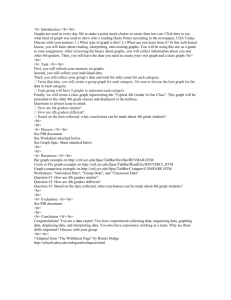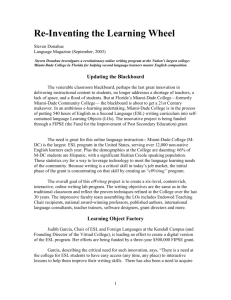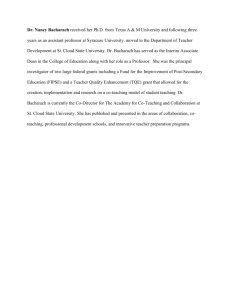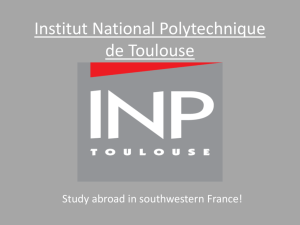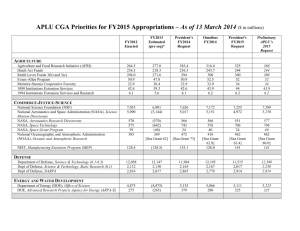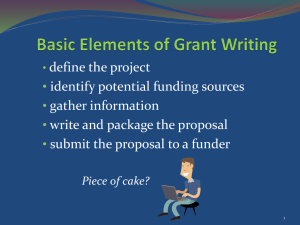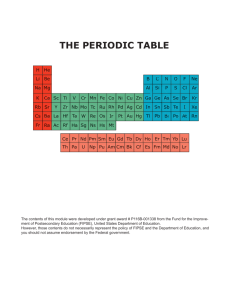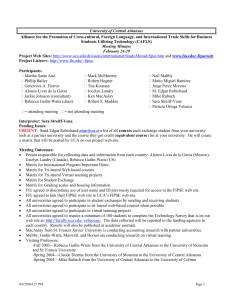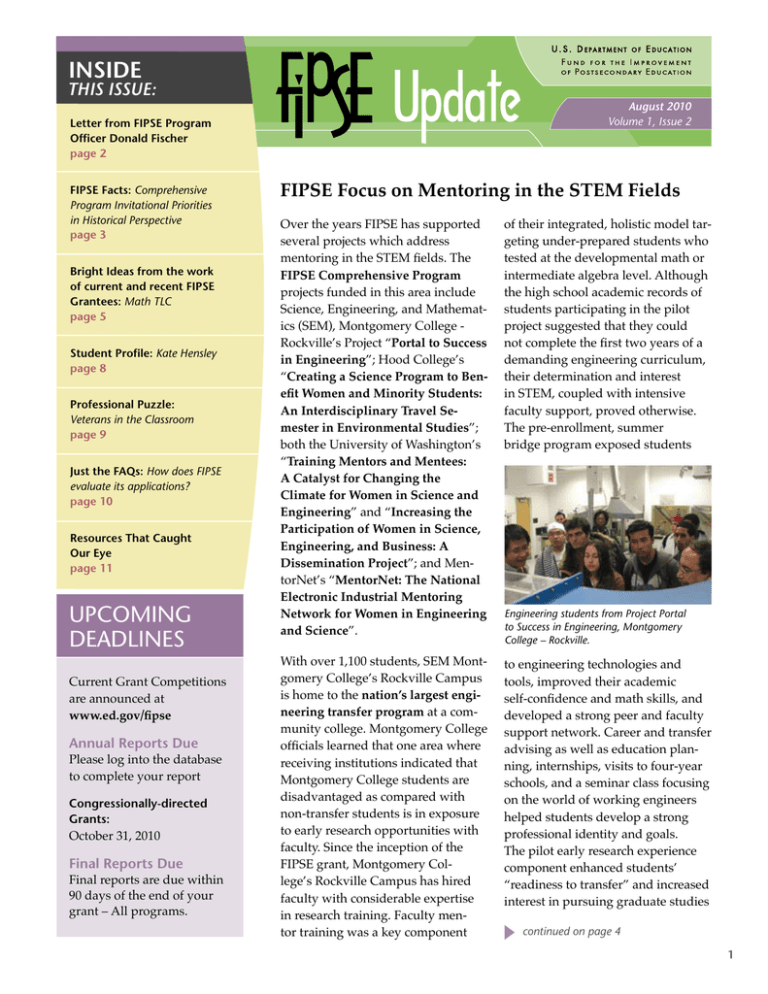
p
Update
UPDATE
Inside
this issue:
August 2010
Volume 1, Issue 2
Letter from FIPSE Program
Officer Donald Fischer
page 2
FIPSE Facts: Comprehensive
Program Invitational Priorities
in Historical Perspective
page 3
Bright Ideas from the work
of current and recent FIPSE
Grantees: Math TLC
page 5
Student Profile: Kate Hensley
page 8
Professional Puzzle:
Veterans in the Classroom
page 9
Just the FAQs: How does FIPSE
evaluate its applications?
page 10
Resources That Caught
Our Eye
page 11
Upcoming
Deadlines
Current Grant Competitions
are announced at
www.ed.gov/fipse
Annual Reports Due
Please log into the database
to complete your report
Congressionally-directed
Grants:
October 31, 2010
Final Reports Due
Final reports are due within
90 days of the end of your
grant – All programs.
FIPSE Focus on Mentoring in the STEM Fields
Over the years FIPSE has supported
several projects which address
mentoring in the STEM fields. The
FIPSE Comprehensive Program
projects funded in this area include
Science, Engineering, and Mathematics (SEM), Montgomery College Rockville’s Project “Portal to Success
in Engineering”; Hood College’s
“Creating a Science Program to Benefit Women and Minority Students:
An Interdisciplinary Travel Semester in Environmental Studies”;
both the University of Washington’s
“Training Mentors and Mentees:
A Catalyst for Changing the
Climate for Women in Science and
Engineering” and “Increasing the
Participation of Women in Science,
Engineering, and Business: A
Dissemination Project”; and MentorNet’s “MentorNet: The National
Electronic Industrial Mentoring
Network for Women in Engineering
and Science”.
of their integrated, holistic model targeting under-prepared students who
tested at the developmental math or
intermediate algebra level. Although
the high school academic records of
students participating in the pilot
project suggested that they could
not complete the first two years of a
demanding engineering curriculum,
their determination and interest
in STEM, coupled with intensive
faculty support, proved otherwise.
The pre-enrollment, summer
bridge program exposed students
With over 1,100 students, SEM Montgomery College’s Rockville Campus
is home to the nation’s largest engineering transfer program at a community college. Montgomery College
officials learned that one area where
receiving institutions indicated that
Montgomery College students are
disadvantaged as compared with
non-transfer students is in exposure
to early research opportunities with
faculty. Since the inception of the
FIPSE grant, Montgomery College’s Rockville Campus has hired
faculty with considerable expertise
in research training. Faculty mentor training was a key component
to engineering technologies and
tools, improved their academic
self-confidence and math skills, and
developed a strong peer and faculty
support network. Career and transfer
advising as well as education planning, internships, visits to four-year
schools, and a seminar class focusing
on the world of working engineers
helped students develop a strong
professional identity and goals.
The pilot early research experience
component enhanced students’
“readiness to transfer” and increased
interest in pursuing graduate studies
Engineering students from Project Portal
to Success in Engineering, Montgomery
College – Rockville.
continued on page 4
1
Update
August 2010
What does FIPSE mean by “innovation”?
Fund for the Improvement of
Postsecondary Education
U.S. Department of Education
6th floor
1990 K Street, NW
Washington, DC 20006-8544
Since 1987
Phone: 202-502-7500
Fax: 202-502-7877
E-mail: fipse@ed.gov
A Note From
the Editor
Dear FIPSE
Alumni and
Friends:
FIPSE
has been
overwhelmed
by the
Susan Lehmann
Education Research positive
Analyst, FIPSE
response to
the FIPSE
Update – I’m adding names
to the newsletter mailing list
daily. Several of you wrote with
suggestions for student profiles
and you will see the first one in
this issue. I did want to clarify
that follow-up information on
students who participated in
any FIPSE projects, not only
international ones, is welcome.
Depending on the volume of
material we receive, we may
start a separate page on our
Web site for the profiles.
continued on page 9
2
Since 1973, FIPSE has stressed the need for improvements
in postsecondary education and funded over 2,000
projects to that end through its Comprehensive Program
competitions. Comprehensive Program announcements
have particularly called for “innovations” in priority
areas of postsecondary education. However, prospective
grant applicants are often unclear about what constitutes
an innovation from FIPSE’s standpoint, which isn’t
Donald Fischer
surprising, considering that innovation is ultimately a
FIPSE Program Officer, matter of perception.
Innovation means “renewal.” For FIPSE’s purposes
innovation means new or improved substantive ideas, information, or content
perceived by postsecondary educators as new from a national perspective. It
may take the form of a product, a format, a program, a practice, a process, or any
other structure or dynamic phenomenon that is not conventional or standard in
a field or discipline. Project ideas may be innovative if they have rarely or never
been tried before, or if there is a significant challenge in adapting them to new
settings or new target populations. One typically defines an innovation through
comparisons with standard or conventional practices. The innovation may not
be revolutionary or paradigm-shifting, but it should be a significant next step.
Many innovations occur when educators borrow an idea from one field or
domain and apply it to another where it is unknown, such as a patient safety
curriculum for medical schools modeled on airline crew protocols. Innovation
may involve a new instructional process that increases the depth and speed
of learning. It may be a set of administrative procedures that is significantly
more effective or more cost-effective than conventional procedures. It may be
quantitative information that is not typically included in a humanities course.
Different degrees of innovativeness may be found in FIPSE projects, but even
those with minor, but well developed and implemented, improvements may
yield significant benefits.
FIPSE views innovations in a national context. We are looking for new or
improved models that grantees may develop for their own use but are adaptable
and affordable for many other users nationwide. Successful applicants frame
their improvement efforts with a view toward more widespread utility.
Innovations obsolesce. Many previous innovations in postsecondary education
have become standard practices. In the late 1990s, FIPSE funded Web-based
courses, which were then considered innovative; now most institutions of
higher education use the Web for instruction. However, perennial and complex
problems in postsecondary education continue to foster creative new solutions.
FIPSE hopes to fund the best of those solutions.
Donald Fischer
FIPSE Program Officer, Since 1987
Update
August 2010
FIPSE FACTS
Comprehensive Program Invitational Priorities in Historical Perspective
FIPSE’s flagship program is the
Comprehensive Program. As FIPSE
heads towards its 40th anniversary
in 2012, we thought it would be
interesting to look at where we
have been. In this issue we present
a review of the invitational funding
priorities that FIPSE has used in the
field of curriculum design between
1973 and 2010. Though applicants
have never been obligated to address
invitational priorities in their
applications, and they receive no
additional points from reviewers for
doing so, a look at the invitational
priorities over time gives a sense
of the educational trends that were
considered important by FIPSE staff,
Department of Education officials,
Congress, and the field.
FIPSE Comprehensive Invitational Funding Priorities from 1973 to 2010 Category 2: Curriculum
Blending Special
Purpose Programs of
Industry, Business, the
Military, Private
Trade, and Technical
Schools with the
Broader Academic
Programs of Colleges
and Universities
2001
2005
1986
1984 1985
1994
1999
2002 2004
2010
2006 2008
1984
1993
1979
1973
Graduate and
Professional Education
Aligning Curriculum
Between High Schools
and Colleges and
Between 2-and 4-year
Postsecondary
Programs
Curricular Reform
73 75
77
79
81
83
85
87
89
91
93
95
97
99
01
03
05
07 09 10
Core Requirements and
General Education
Program Year
Save the Date
U.S.-Brazil Project Directors’
Meeting, September 23-26, 2010,
Florianopolis, Santa Catarina, Brazil.
When online registration opens,
grantees will be able to register at
http://www.ltiweb.org/XP/XP-EasyPortal/Site/XP-PortalPaginaShow.
php?id=872.
EU-U.S. Atlantis Project Directors’
Meeting, October 13-15, 2010, Berlin,
Germany. When online registration
opens, grantees will be able to
register at http://eacea.ec.europa.
eu/extcoop/events/annual_projects_directors_2010_en.htm.
North American Mobility in
Higher Education Program Project
Directors’ Meeting, October 24-26,
2010, University of Minnesota,
Minneapolis, MN. When online
registration opens, grantees will be
able to register at http://www.cce.
umn.edu/2010-North-AmericanProgram/index.html.
Centers of Excellence for Veterans’
Student Success Workshop, November 10, 2010,Washington, D.C.
Project Directors’ Meeting for the
Comprehensive Program, Special
Focus Programs, and the Pilot
Program for Course Materials
Rental Projects, December 14-15,
2010, Capital Hilton, 1001 16th
Street NW, Washington, D.C. When
online registration opens, grantees
will be able to register at http://
fipse.edmeetings.com/.
3
Update
August 2010
continued from page 1
in the STEM fields. Its achievements include students who have
made presentations at national and
international conferences, and one
student who has a patent pending
for a mechanical device used in a
space shuttle mission.
selected Web
sites referenced
in this article:
Association for Women
in Science
http://www.awis.org/
Center for Workforce
Development
http://www.engr.washington.
edu/cwd/CWDHome.html
Hood Coastal Studies
Program
http://www.hood.edu/
academics/resources.
cfm?pid=resources_
coastal.html
Latinas in Computing
http://anitaborg.org/
initiatives/systers/lic/
MentorNet
http://www.mentornet.net/
Science, Engineering,
and Mathematics (SEM),
Montgomery College –
Rockville
http://cms.montgomery
college.edu/edu/department2.
aspx?id=4957
WEPAN
http://www.wepan.org/
4
Faculty mentoring has contributed to
a 96% retention rate in college and a
75% retention rate in engineering. By
the end of the spring 2010 semester,
20 out of 30 cohort students from
underrepresented groups had
transferred to four-year engineering
programs and several have received
competitive scholarships. In the
words of Yanira Gutierrez, “FIPSE
has made a big difference. I knew I
wanted to be an engineer, but right
out of high school, I didn’t have the
math skills or confidence to succeed.
Engineering is really competitive.
The program helped me focus
my goals. I will transfer fall 2010,
ready to compete with university
students. Now I am self-driven,
mature, and can take initiative.” We
encourage you to listen to some of
the program’s podcasts for more
information about the program and
its achievements.
The second FIPSE STEM mentoring
project we would like to highlight
is the Hood Coastal Studies Program, which provides an intensive
semester that focuses on coastal
environments of the Chesapeake Bay
Watershed and Mid-Atlantic from
several perspectives simultaneously:
scientific, literary, historical, and
cultural. Students and faculty travel
roughly a month during the semester, stopping at several marine field
laboratories and staying for one- to
two-week intervals. Interactions
with scientists, authors, and other
environmental professionals in the
region augment class discussions,
laboratory investigations, and fieldwork. An interdisciplinary research
practicum weaves together scientific,
historical, and cultural threads to
unify the semester-long experience.
Recently, the Program has expanded
to offer a minor in Coastal Studies
that augments the semester-long
experience with additional fieldintensive courses in such areas as
South Florida, the Caribbean, or
Coastal Maine. According to Project
Director Drew Ferrier, “Our FIPSE
grant was the help we needed to get
the program started. We’re now an
integral part of the Hood curriculum,
have been able to attract additional
funding, and are entering our second
decade of operation!”
The University of Washington
received both an initial FIPSE
Comprehensive grant and a followon dissemination grant for their
“Curriculum for Training Mentors
and Mentees and Increasing Access,”
which is now used by over 350
institutions throughout the world.
Currently the Center for Workforce
Development (CWD) at the University of Washington offers two
mentoring programs. The Faculty
and Graduate Mentoring Program
aims to increase the recruitment and
retention of graduate students from
underrepresented groups, including
women and individuals of color.
The Nanotechnology Mentoring
Program pairs students affiliated
with the Center for Nanotechnology
with mentors in industry or faculty
positions to learn about practical
applications of nanotechnology.
Women in Science and Engineering
(WISE), the pre-cursor to CWD,
received the prestigious White
House 1998 Presidential Award of
Excellence in Science, Engineering
and Mathematics Mentoring and the
1998 WEPAN National Women in
Engineering Program Award.
continued on page 6
Update
August 2010
Bright Ideas from the work of current and recent FIPSE Grantees.
Combining Technology with Traditional
Approaches to Improve Student Outcomes
in Introductory Algebra Courses
Math TLC has also
been successful in
reducing the minority
achievement gap in
remedial math by more
than 80%.
Web sites
referenced in
this article:
2006 FIPSE Project
http://www.fipseaed.org/
grantshow.cfm?grant
Number=P116B060111
Math TLC Home
http://mathtlc.uwstout.edu/
index.html
Math TLC Online
Software Demo
http://mathtlc.uwstout.
edu/Visit%20Course%20
Web%20Site.html
Course Redesign
Workshop Information
http://mathtlc.uwstout.edu/
FIPSE_WorkshopInfo.html
continued on page 6
In the past six years the new Math
Teaching and Learning Center
(Math TLC) program at the University of Wisconsin (UW) – Stout
has served over 4,000 students and
achieved a 52 percent reduction
in failure/withdrawal rates in
Beginning (remedial) Algebra and
a 39 percent reduction in failure/
withdrawal rates in Intermediate
Algebra compared to the four
previous years. The Math TLC
program has resulted in nearly 600
more students passing introductory
algebra courses than would have
passed given historical success
rates, potentially increasing overall
university retention by as much
as 3.5 percentage points over this
period. The program has also been
successful in reducing the minority
achievement gap in remedial math
by more than 80 percent. Consequently, more students are now
able to choose science, technology,
engineering, and math (STEM) or
business majors.
The most recent annual Course
Redesign Workshop funded by
a 2006 FIPSE Comprehensive
Program grant was held at the University of Wisconsin (UW) – Stout
campus in June 2009. The three
FIPSE-funded workshops hosted
a total of 45 participants from 12
states representing 29 postsecondary institutions and one high school.
Participants reported that the workshops provided them with highly
valuable content and materials, and
that the time spent at the workshop
was definitely worthwhile in terms
of usefulness for their immediate
and future hybrid course development and delivery. Outcome
evaluations have been completed
on fall-semester implementation of
24 redesigned courses by 2007, 2008,
and 2009 workshop participants.
Despite the technical challenges
associated with implementing a
computer-assisted learning environment, analysis showed that
these first-iteration redesigns have
resulted in statistically significant
decreases in failure/withdrawal
rates in 38 percent of implemented
courses compared to higher rates in
only 8 percent of these courses.
The redesign workshop results have
been disseminated, via workshops,
to 32 postsecondary institutions and
two high schools. All materials and
resources from the course redesign
workshops have been posted on
a public access Web site. This link
will take you to a white paper
published by Pearson-Prentice Hall
which features six schools across
the United States that are using the
MyMathLab course software in
innovative and successful ways. The
University of Wisconsin – Stout’s
four-year progress report is also
available online. Interested persons
may also explore the online software used in the Math TLC courses.
continued on page 6
5
Update
continued from page 4
One of the oldest FIPSE-funded STEM mentoring projects targeting
underserved populations in the sciences is MentorNet, an independent
award-winning e-mentoring network for diversity in engineering and
science. According to former FIPSE Program Officer Joan Straumanis,
“MentorNet was a hard sell at FIPSE (in 1998) because it was independent and new – not associated with any university or other existing
organization (although it was originally housed at San Jose State
University). In that respect it … [carried] forward the old FIPSE spirit
of the 1970s, when all kinds of new organizations and enterprises were
founded with FIPSE support.” MentorNet received a FIPSE Comprehensive grant in 1998 to support the fledgling mentoring network
being developed with help from WEPAN, the Women in Engineering
Programs & Advocates Network. The MentorNet site received another
FIPSE Congressional Priorities Project grant in 1999 entitled “MentorNet 3C: An Electronic Mentoring Program to Encourage Community
College Women to Enter Careers in Technology and Business.”
Since FIPSE funding ended in 2003, MentorNet has continued to
expand. Currently 719 companies, including IBM, AT&T, and Texas
Instruments, have staff signed on as mentors. There are 167 mentors
available to be matched and 1,229 mentors currently matched. Approximately 45 percent of the mentors are female, and mentors cover a
range of occupations including engineers, scientists, programmers, and
CEOs. The site provides a list of the colleges and universities which
currently participate in MentorNet. The most recent demographics for
protégés of the network show that
August 2010
Bright Ideas, cont’d
continued from page 5
This FIPSE-funded project received
the University of Wisconsin (UW)
System 2008 Regents Award for
Teaching Excellence, awarded annually to one academic department
out of the 26 public colleges and
universities statewide. The project
team was also recently awarded
more than $100,000 in funding
from the UW System Office of
Equity, Diversity and Inclusion for
a two-year project to develop and
pilot a summer program aimed
at further reducing the minority
achievement gap in math.
Web sites, cont’d
Course Redesign Work-
shop and Materials
http://mathtlc.uwstout.
edu/2009%20Workshop%20Materials%20
•2% of the protégés are American Indian or Alaskan Native,
and%20Resources.html
•35% are Asian /Asian American,
University of Wisconsin–
Stout’s Four-Year
Progress Report
•14% are Black /African American,
•9% are Hispanic or Latina /o,
•1% are Native Hawaiian or Pacific Islander, and
•45% identify as White.
Fifty-six percent of the protégés are female and more than half of the
protégés are in Bachelors programs. On April 10, 2008, the Association
for Women in Science (AWIS) announced that they were partnering
with Latinas in Computing (LiC) “to expand mentoring opportunities to Latina students and professional women in computing via the
e-mentoring network MentorNet.” MentorNet has won numerous
awards including the 2006 Anita Borg Social Impact Award and the
2001 Presidential Award for Excellence in Science, Mathematics and
Engineering Mentoring.
6
http://mathtlc.uwstout.edu/
pdfs/Math%20TLC%20
report%20updated%20
Sept%202008.pdf
Making the Grade
White Paper
http://www.pearsoned.
com/RESRPTS_FOR_POSTING/HIGHER_ED_RESEARCH_STUDIES/
makingthegrade2.pdf
Update
August 2010
What are FIPSE Grantees Working On?
FIPSE holds several competitive grant competitions and
manages non-competitive Congressionally-directed
grants (earmarks). FIPSE initially classifies each project
according to its main subject area(s). Grantees are able to
modify this classification to include other major subject
areas that their work seeks to address.
A note about the two charts: (See page 12 for chart two.)
1.Grants can cover several subjects, so percentages
do not total 100%, and
2.Awards vary greatly in size, so you can draw no
conclusions about dollars spent from these charts.
Congressionally-directed Grants, FY 2006 – FY 2009
(N= 662 grants. Grants may cover multiple subject areas; therefore, the chart does not total 100%.
Subjects covered by fewer than 5% of grantees are not included.)
Adult Education
5%
Faculty Development
5%
Distance Learning
7%
Teacher Ed/Teacher
Training
9%
Access, Retention, and
Completion
11%
Curricular Reform
17%
Technology/Instructional
Technologies
30%
Equipment and Materials
Acquisition
58%
0%
10%
20%
30%
40%
Critical Thinking
50%
60%
70%
80%
90%
100%
11%
Please help us be
a resource for you!
Teaching Effectiveness
FIPSE would like to make the FIPSE database more useful
Articulation and School-College Partnerships
for people working in the field of postsecondary education.
Dissemination
If you look at the University of Wisconsin
– Stout’s current
Comprehensive Program grantCurricular
abstractReform
page you will see the
information we currently post for a typical grant. If you go
Mentoring
to our Advanced Search page you can see our current search
Assessment
and Evaluation
options. So thinking about
our database
as a resource for
information about funded projects,
Distance Learning
13%
•What search tools would you like to better locate the
information you want?
13%
15%
•If you think we should re-package the information to
15%make it more useful, tell us how, or send us a link to a
Web site that you like as a model.
16%
17%
Send
us your simple ideas and your complicated ones to
susan.lehmann@ed.gov.
17%
•What additional information do you need to foster
Faculty Development
change at your institution?
21%
Access, Retention, and Completion
28%
Technology/Instructional Technologies
31%
Teacher Ed/Teacher Training
31%
0%
5%
10%
15%
20%
25%
30%
35%
7
40%
45%
50%
Update
August 2010
FIPSE Student Profile – Kate Hensley
International Teams in Engineering Industrial Projects: A Cooperative
Manufacturing and Production Engineering Program
Project Director: Dr. Robert Young
Professor: Edward P. Fitts Department of Industrial Engineering,
North Carolina State University
Grant P116M020013, U.S.-Brazil
Higher Education Consortia Program, Grant Dates: 9/2002-8/2007
Project Description: The manufacturing and production engineering
consortium created teams of U.S.
and Brazilian engineering students
to solve engineering design problems in manufacturing and production at companies in the United
States and Brazil. The project gave
universities in both countries the
opportunity to participate in the
exchange of engineering students
and helped students learn how to
work in multinational engineering
design teams. It also enhanced the
language skills of the students and
their ability to understand different social and technical cultures.
Among the many things that
students rated highly about the
experience was that they gained
recognition that there are different ways to achieve goals. They
also reported that they gained
confidence in being assigned to
work in an emerging industrialized
country. Eighteen U.S. students and
23 Brazilian students participated in
the exchange.
Profile: Kate Hensley, who earned
her Bachelor’s Degree in Science
and Industrial Engineering at
North Carolina State University,
was part of the group of students
8
who first participated in this project
in the spring of 2004. During the
seven-month exchange Kate lived
in a women’s residence hall that
doubled as a nunnery. Kate’s
coursework was primarily in Portuguese, which she did have difficulty
adjusting to at first, though she does
credit her peers with helping her
adjust to her work in the program.
As a result of her participation in
the project, Kate changed her major
to Industrial Engineering. When
she graduated, she was hired by
Sikorsky Aircraft Corporation in
Connecticut and made responsible
for procurement for Sikorsky’s
subcontractors in Brazil. Kate
credits her being chosen as a
partner-manager for a helicopter
platform to her participation in the
program. Later on, Kate decided
to pursue her Master’s in Management Operations at Rensselaer
Polytechnic Institute with the aid
of Sikorsky. She has now moved up
and is on loan to United Technologies setting up maintenance and
repair facilities in Abu Dhabi in the
United Arab Emirates.
After participating in the U.S.Brazil Higher Education Consortia
Program and living in a different
culture, Kate has learned how to
appreciate the smaller things in
her own culture, such as southern
cooking and considerate people.
The exchange also taught Kate to
be more perceptive of the world
around her rather than just focusing
on her personal life on a day-to-
day basis. Kate’s most memorable
learning experience was learning
how to adjust to a different environment and realizing that she could
go anywhere in the world and be
able to survive. Kate’s favorite parts
of the program were the friendly
people she met and the beaches.
Kate advises any faculty members
who are considering FIPSE study
abroad programs that the programs
are going to be valuable in the long
run to the American workforce as
companies begin to grow and globalize. Her advice to any students
considering the program: “Don’t
worry so much about finishing
school so early. Use time in college
to acquire skills that will get you
where you want to go, and if you
have the opportunity to travel
abroad, take it!”
Profile written by Ricardo Howard,
FIPSE’s summer intern. Ricardo is a
sophomore at Georgia State University
majoring in accounting.
Don’t worry so much
about finishing school
so early. Use time in
college to acquire
skills that will get you
where you want to go,
and if you have the
opportunity to travel
abroad, take it!
Update
Professional Puzzle: Veterans in
the Classroom
Each newsletter we will pose a few questions about a
topic relating to institutional change, faculty development, or student
learning. Please e-mail your responses or ideas for future issues to the
editor and put the words “Professional Puzzle” in the subject line.
Veterans in the Classroom
Are there comprehensive sources of information about educational
services which cater to veterans?
Are there innovative programs out there that are designed to provide
educational resources or services to veterans seeking to pursue
postsecondary education?
Are there programs to assist in the successful educational advancement and reintegration of disabled veterans through the development
of physical, academic, social, and career skills that provide opportunities for the pursuit and attainment of a postsecondary degree and job
placement?
Are there any fast-track programs designed specifically to build on
military training and help veterans re-tool for a civilian career?
Are there sources of information and assistance in gaining transfer
credit for competencies acquired and documented in the military?
Are veterans different from the typical adult student, and if so, what
academic skill-building, career, and education planning resources do
they need?
August 2010
continued from page 2
We did decide that in the interest of
space we would re-route you to our
Web site for the reflective material
generated by the May issue’s
Professional Puzzle. Thank you to
several FIPSE project directors for
taking the time to be interviewed by
me for the follow-up on ePortfolios.
Also in the interest of space you
will notice that this issue’s cover
story doubles as our Nurturing
Innovation: Profiles of Former FIPSE
Projects That Grew.
Please feel free to send us your
suggestions and requests for items
that would interest you as a former
or current FIPSE grantee, former
FIPSE employee, or interested
reader from the higher education
community. Please also feel free
to forward this newsletter to
colleagues.
Best,
Dr. Susan Lehmann, Education
Research Analyst, FIPSE
susan.lehmann@ed.gov
FIPSE Project Directors willing to answer e-mail about their experience with integrating veterans into the classroom should contact
susan.lehmann@ed.gov.
Responses to the May Professional Puzzle on ePortfolios may be
found on the FIPSE Update Web page. Please feel free to send in
additional links to ePortfolio resources or comments based on your
experience with ePortfolios. If we receive additional information, we
will update the posting.
The definition of “veteran” provided by the Office of General Counsel, U.S. Department of
Education, and taken from section 480 (c)(1) of the Higher Education Act of 1965, which
applies to Federal Student Aid programs, is as follows: A veteran is an individual who “has
engaged in the active duty in the United States Army, Navy, Air Force, Marines, or Coast
Guard” and “was released under a condition other than dishonorable.”
9
Update
August 2010
Just the FAQs
FIPSE Logos
Project directors for competitive
FIPSE grant programs are aware
that we want project Web sites to
both acknowledge FIPSE funding
and sport one of our logos. By
putting a logo on your project you
make it much easier for FIPSE staff
and supporters to locate you and
learn from your experience. (One
project director compared it to
tagging sharks to track their habits
and we like that idea.)
Logos can be searched using an image search. A FIPSE image search,
as opposed to a typical Internet
keyword search, weeds out all the
federal documents that cite FIPSE.
What remain are primarily links
to FIPSE-funded projects. If you
are a FIPSE project director, past or
present, and you maintain a project
Web site, please contact susan.
lehmann@ed.gov for information
about how to download a highresolution logo.
In the meantime, FIPSE would like
to applaud the creativity of the
Pratt Center for Sustainable Design Studies for their unique take
on the FIPSE logo seen here. We
invite you to check out their Web
site and click on the “projects” tab
to find out what they are up to.
How does FIPSE evaluate its applications?
1.FIPSE’s competitive grant review process changed substantially in
2007. Today FIPSE grants are reviewed by field readers in a onestage process. FIPSE staff continue to provide consultation with
applicants, but are no longer involved in the actual review and
evaluation of proposals.
2.Each application is typically assigned to three readers. None of the
readers can be from the applicant’s institution or state. FIPSE staff
strives to assign proposals to a team of readers who among them
possess topic expertise, field expertise, and general knowledge of
higher education. This means two things:
•applicants should take care to write accurate project abstracts
because abstracts are the tool that FIPSE staff use to assign a
proposal to reviewers, and
•applicants should take care to write for non-experts because one
or two of the three field readers will likely not be an expert on the
proposal topic.
3.It is also very important for applicants to read grant application
instructions, which indicate how many points applicants may earn
by addressing specified selection criteria. Reviewers score applications with reference to the total points allotted to each of several
criteria. FIPSE works closely with reviewers each year to make sure
that reviewers don’t merely check off selection criteria as “present”
without regard to the substance of ideas discussed in each section.
A common mistake that applicants make is to spend too much of
their limited space describing a national problem at length. It would
be wiser to quickly set the stage for your idea and devote more
space to explaining the details of your innovative plan. Another
common mistake that applicants make is to write in a vacuum with
no reference to research or findings that are already known. An ideal
FIPSE grant should build on the work of others, not reinvent it.
4.The total points awarded by three reviewers is used to rank grant
applications. Once the review process is complete, a “slate” is
created with projects ranked from high to low.
An ideal FIPSE grant should build on the
work of others, not reinvent it.
10
Update
August 2010
Resources that caught our eye
Web Sites
Articles
www.ehow.com
This is a Web site with advice about how do almost
anything. It is free and contains thousands of videos.
There are almost 20,000 posts on college and higher
education, over 10,000 posts on vocational education
topics, and almost 30,000 posts on K-12 education.
Posts are rated by readers making it easy to find
higher quality ones.
Carrel, Scott E. and James E. West. 2010. “Does
Professor Quality Matter? Evidence from Random
Assignment of Students to Professors.” Journal of
Political Economy, vol. 118, no. 3, pp. 409-432.
www.readability.com
Readability is a free, downloadable tool that makes
reading on the Web more enjoyable by removing the
ads and clutter surrounding the text you are reading.
You can personalize it with your own font and margin
size preferences. It works with Safari, Firefox, and
Chrome, but not Internet Explorer.
Books
Croxall, Brian. 2010. “Reflections on Teaching with
Social Media.” Chronicle of Higher Education, June 7,
2010.
Kolowich, Steve. 2010. “Whither the Wikis?” Inside
Higher Ed, July 14, 2010.
McClurken, Jeff and Julie Meloni. 2010. “‘How are
you going to grade this?’: Evaluating Classroom
Blogs.” Chronicle of Higher Education, June 21, 2010.
Stone, David A. 2010. “Becoming a Successful
Principal Investigator.” Chronicle of Higher Education,
July 7, 2010.
Pink, Daniel H. 2006. A Whole New Mind: Why
Right-Brainers Will Rule the Future. Riverhead
Trade. For his TED talk on the science of motivation
see www.ted.com/talks/dan_pink_on_motivation.
html.
n STEM Fields?
What Percentage of FIPSE Competitive Grants are in STEM Fields?
FY 2006 – FY 2009
(N= 329 Competitive Grants)
Non-STEM
44%
STEM
56%
11
Update
August 2010
continued from page 7
Comprehensive Grants by Subject, FY 2006 – 2009
(N= 75 grants. Grants may cover multiple subject areas; therefore, the chart does not total 100%.
Subjects covered by fewer than 10% of grantees are not included.)
Critical Thinking
11%
Teaching Effectiveness
13%
Articulation and School-College Partnerships
13%
Dissemination
15%
Curricular Reform
15%
Mentoring
16%
Assessment and Evaluation
17%
Distance Learning
17%
Faculty Development
21%
Access, Retention, and Completion
28%
Technology/Instructional Technologies
31%
Teacher Ed/Teacher Training
31%
0%
5%
10%
15%
20%
25%
30%
35%
40%
45%
50%
FIPSE’s Mission
The Fund for the Improvement of Postsecondary Education (FIPSE) is a unit of the Higher Education Programs
located within the Office of Postsecondary Education, U.S.
Department of Education. FIPSE’s mandate is to “improve
postsecondary educational opportunities”
across a broad
1986
range of concerns. Although a small program, FIPSE has
established a record of promoting
meaningful and1994
lasting
1984 1985
solutions to various, often newly emerging, problems and
1984 education for all1993
of promoting the highest quality
learners.
Through its primary vehicle, the Comprehensive Program
1979
1973
grant competition, FIPSE seeks to support the implementation of innovative educational reform ideas, to evaluate
how73well
learned
75 they
77 work,
79 and
81 to
83share
85 the
87lessons
89 91
93 with
95 97
the larger education community.
Program Year
Fund for the Improvement of Postsecondary Education
U.S. Department of Education, 6th floor
1990 K Street, NW
Washington, DC 20006-8544
12
Phone: 202-502-7500
Fax: 202-502-7877
E-mail: fipse@ed.gov
FIPSE defines postsecondary education
broadly.
Its
Blending
Special
Purpose Programs of
applicants include a wide variety of industry,
nonprofit
agencies
and
Business,
the
Military, Private
institutions offering education after high
school,
Trade, and
Technicalsuch as
2001
Schools with the
colleges and universities (public andBroader
private,
two or four
Acedemic
Programs of Colleges
year, undergraduate
and
graduate),
technical
and busiand
Universties
2005
ness schools, testing agencies, professional
associations,
Graduate and
Professional Education
employers
and local
education agencies,
1999
2002 and
2010
2004unions, state
student organizations,
cultural institutions,
and com2006 2008
Aligning Curriculum
Between High Schools
munity groups. FIPSE supports newand
asColleges
well as
and established
Between 2-and 4-year
organizations, but it cannot award grants
to for-profits or
Postsecondary
Programs
unaffiliated individuals.
Curricular Reform
99
01
03
05
07 09 10
Core Requirements and
General Education

